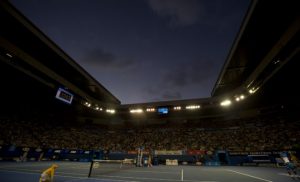Experience and Planning Help ESPN Meet Special Challenges Covering Australian Open
Extreme distance, time difference impact logistics and transmission
Story Highlights
ESPN is out in full force for its 26th consecutive year covering the Australian Open: 253 technical and production personnel on hand at Melbourne Park. Tennis’s first major of the year always presents unique challenges for ESPN — most notably, the extreme distance and time difference (16 hours) between Melbourne and ESPN headquarters in Bristol, CT.
“The time difference between Bristol and Melbourne is one of the challenges, and the distance also makes it challenging from a transmission, planning, and delivery side,” says Dennis Cleary, director, remote production operations. “However, the years of experience working this event from our operations teams both in Australia and in Bristol helps alleviate some of these challenges.”
Tennis Australia Back in Action: Host Broadcaster Serves Up Feeds for ESPN
ESPN is using cabin space provided by Tennis Australia for four control rooms for ESPN’s primetime production, ITV (the six-screen mosaic on DirecTV), ESPN International, and Tennis Channel. Gearhouse Broadcast is once again providing technical facilities for Tennis Australia’s host broadcast — as it does for ESPN’s host- and domestic-feed operations at the US Open.

In the first 10 days of the Australian Open, late-running matches extended ESPN’s live coverage by 15% over what had been scheduled.
As usual, ESPN selects an assortment of feeds from Tennis Australia and produces its domestic, international, and ITV broadcasts around those host feeds. Individual court feeds are also transmitted to Bristol for digital distribution.
“Having a single vendor in Gearhouse providing ESPN technical facilities and Tennis Australia host-broadcast facilities does provide efficiencies with onsite resources and engineering support,” notes Cleary.
Long-Distance Relationship: Managing Latency, Logistics Between Melbourne and Bristol
Given the more than 16,000 miles between Melbourne and Bristol, ESPN is dealing with a 115-ms delay for communications and two seconds for video over fiber. In addition, the distance means that ESPN’s operations team must be extra careful to ensure that all equipment is shipped on time.
“While planning for the tournament,” Cleary explains, “we need to make sure we have all of our shipments in line and in the hands of our vendor early so they can all arrive on time in Australia. If equipment breaks or something is forgotten, it is not easy to get something shipped from the U.S. overnight.”
Onsite at Melbourne Park: Garden Square Set, NetCam, Spidercam
ESPN’s studio set in Melbourne is once again located on the gantry overlooking Garden Square.
As for highlights of match coverage, ESPN once again has access to Tennis Australia’s NetCam at Rod Laver, Margaret Court, and Melbourne arenas. A Spidercam wired aerial system is also deployed at Rod Laver Arena.
This year’s operation is led by Manager Joalin Goff, Senior Operations Coordinator Antonio Demasi, Senior Remote Operations Specialist Steve Raymond, Remote Operations Specialist Sam Olsen, and Senior Operations Producer Joa O’Connor — all of whom will have been onsite for a total of 27 days by the time the tournament concludes.
“Over the past years,” says Cleary, “ESPN has continued to work with all of our vendors and production to find efficiencies while increasing the amount of content we produce and distribute across all of our platforms. I am very proud of our onsite operations team. Planning for the Australian Open, French Open, Wimbledon, and the US Open is a year-round commitment.”
ESPN’s production and operations teams have been working as hard as ever in Melbourne, televising 110 hours of live coverage during the tournament’s first 10 days. Thanks to long-running matches’ extending the telecast windows into the morning hours, that coverage was 15% over the 95.5 hours scheduled. The teams’ efforts have paid off: the audience for ESPN overnight live telecasts through the first 10 days was up 35% from a year ago, averaging 335,000 viewers vs. 249,000 in 2018.
